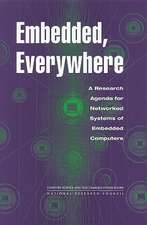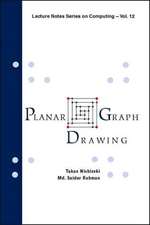Microsoft® Exchange Server 2003 Deployment and Migration: HP Technologies
Autor Kieran McCorryen Limba Engleză Paperback – 8 sep 2004
* Details for consultants and system administrators to migrate from older versions of Exchange 5.5 and Exchange 2000
* Critical information on integration with Outlook 2003 and Windows 2003
* Based on actual implementations of both beta and final release versions of Exchange 2003 in larger enterprise environments
Din seria HP Technologies
- 20%
 Preț: 776.22 lei
Preț: 776.22 lei - 20%
 Preț: 408.69 lei
Preț: 408.69 lei - 20%
 Preț: 635.24 lei
Preț: 635.24 lei - 20%
 Preț: 549.28 lei
Preț: 549.28 lei - 20%
 Preț: 489.33 lei
Preț: 489.33 lei - 20%
 Preț: 633.24 lei
Preț: 633.24 lei - 20%
 Preț: 751.40 lei
Preț: 751.40 lei - 20%
 Preț: 661.47 lei
Preț: 661.47 lei - 20%
 Preț: 641.84 lei
Preț: 641.84 lei - 20%
 Preț: 655.88 lei
Preț: 655.88 lei - 20%
 Preț: 949.36 lei
Preț: 949.36 lei - 20%
 Preț: 588.42 lei
Preț: 588.42 lei - 20%
 Preț: 427.46 lei
Preț: 427.46 lei - 20%
 Preț: 817.46 lei
Preț: 817.46 lei - 20%
 Preț: 645.41 lei
Preț: 645.41 lei - 20%
 Preț: 621.83 lei
Preț: 621.83 lei - 20%
 Preț: 710.56 lei
Preț: 710.56 lei - 20%
 Preț: 585.67 lei
Preț: 585.67 lei - 20%
 Preț: 619.13 lei
Preț: 619.13 lei - 20%
 Preț: 597.72 lei
Preț: 597.72 lei - 20%
 Preț: 591.26 lei
Preț: 591.26 lei - 20%
 Preț: 618.91 lei
Preț: 618.91 lei - 20%
 Preț: 581.66 lei
Preț: 581.66 lei - 20%
 Preț: 552.58 lei
Preț: 552.58 lei - 20%
 Preț: 680.77 lei
Preț: 680.77 lei - 20%
 Preț: 415.32 lei
Preț: 415.32 lei - 20%
 Preț: 630.12 lei
Preț: 630.12 lei
Preț: 571.02 lei
Preț vechi: 713.78 lei
-20% Nou
Puncte Express: 857
Preț estimativ în valută:
109.28€ • 118.66$ • 91.79£
109.28€ • 118.66$ • 91.79£
Carte tipărită la comandă
Livrare economică 22 aprilie-06 mai
Preluare comenzi: 021 569.72.76
Specificații
ISBN-13: 9781555583163
ISBN-10: 1555583164
Pagini: 400
Ilustrații: 1, black & white illustrations
Dimensiuni: 191 x 235 x 16 mm
Greutate: 0.81 kg
Editura: ELSEVIER SCIENCE
Seria HP Technologies
ISBN-10: 1555583164
Pagini: 400
Ilustrații: 1, black & white illustrations
Dimensiuni: 191 x 235 x 16 mm
Greutate: 0.81 kg
Editura: ELSEVIER SCIENCE
Seria HP Technologies
Public țintă
IT Specialists and Solution Architects involved in the planning and design of a new Exchange 2003 infrastructure and migrating existing Exchange environments.IT Managers that need to understand the technical challenges associated with implementing Exchange 2000 in a trauma-free fashion
Cuprins
- Dedication
- Foreword
- Preface
- What is This Book about?
- Intended Audience
- Acknowledgments
- 1:
Exchange
2003
Deployment
Fundamentals
- 1.1 Introduction
- 1.2 Windows 2000/Windows 2003 Refresher
- 1.3 Exchange 2003 and Its Relationship to the Forest
- 1.4 The Importance of Domain Controllers and Global Catalog Servers
- 1.5 Choosing an Appropriate Domain Model
- 1.6 Universal Security Groups and Windows Domain Mixed-Mode Membership
- 1.7 Token Augmentation
- 1.8 Exchange 2003 Installation Requirements
- 1.9 Exchange System Manager on Windows XP
- 1.10 Exchange 2003 and Internet Information Services 6.0
- 1.11 Exchange 2003 Installation Improvements
- 1.12 Preparing and Planning for Deployment
- 1.13 DCDiag and NetDiag Utilities
- 1.14 Preparing Windows 2003 Domains for Exchange 2003
- 1.15 Installing Exchange 2000
- 1.16 Summary
- 2:
Active
Directory
Connector
Synchronization
- 2.1 Introduction
- 2.2 Active Directory Connector Core Technology Description
- 2.3 Connection Agreements
- 2.4 Active Directory Connector Schema Modifications
- 2.5 Determining Which Directory Objects to Synchronize
- 2.6 Active Directory Connector Block Searching
- 2.7 How the Active Directory Connector Uses the Active Directory
- 2.8 Mailbox-enabled and Mail-enabled Objects
- 2.9 Object Class Mapping from Exchange 5.5 to the Active Directory
- 2.10 Object Class Mapping from the Active Directory to Exchange 5.5
- 2.11 Synchronizing Hidden Objects
- 2.12 Dealing with Hidden Distribution List Membership
- 2.13 Object Deletion
- 2.14 Connection Agreements and Authentication
- 2.15 Controlling the Synchronization Schedule
- 2.16 Connection Agreement Advanced Parameters
- 2.17 Exchange 5.5 Mailboxes and Multiple Windows NT Accounts
- 2.18 Mailbox Delegate Access
- 2.19 Troubleshooting Active Directory Connector Synchronization Problems
- 2.20 The New Exchange 2003 Active Directory Connector Features
- 2.21 Summary
- 3:
Advanced
Active
Directory
Connector
Configuration
- 3.1 Introduction
- 3.2 Default Object-Matching Behavior
- 3.3 How the Active Directory Connector Uses LDAP
- 3.4 Using a Customized LDAP Search Filter
- 3.5 Understanding LDAP Search Filters
- 3.6 Setting an LDAP Search Filter on a Connection Agreement
- 3.7 Default Active Directory Connector Object-Matching Behavior
- 3.8 Using Custom Object-Matching Rules on the Active Directory Connector
- 3.9 The NTDSNoMatch Utility
- 3.10 Summarizing Object-Matching Behavior
- 3.11 Introduction to Attribute Mapping
- 3.12 Default Attribute Mapping Behavior
- 3.13 Moving Beyond the Schema Mapping GUI
- 3.14 Active Directory Distinguished Name Mapping with the Exchange 2000 Active Directory Connector
- 3.15 Distinguished Name Mapping with the Exchange 2003 Active Directory Connector
- 3.16 Exchange 5.5 and LDAP Names
- 3.17 Attribute Mapping Rule Syntax
- 3.18 Summary
- 4:
The
Site
Replication
Service
- 4.1 Introduction
- 4.2 Positioning the Site Replication Service and the Active Directory Connector
- 4.3 Components that Comprise the Site Replication Service
- 4.4 The Site Replication Service in Intrasite Replication Operation
- 4.5 The Site Replication Service in Intersite Replication Operation
- 4.6 What Takes Place during a Bridgehead Server Upgrade?
- 4.7 Site Replication Service Management
- 4.8 Site Replication Service Preference
- 4.9 Summary
- 5:
Public
Folder
Interoperability
and
Migration
- 5.1 Introduction
- 5.2 Public Folder Connection Agreements
- 5.3 Configuring Public Folder Connection Agreements
- 5.4 Public Folder Permissions
- 5.5 Exchange 5.5 and Exchange 2003 Public Folder Replication
- 5.6 Permission Handling during Mixed-Version Replication
- 5.7 Dealing with Zombie Users
- 5.8 Exchange 5.5 Distribution Lists and Access Control Lists
- 5.9 Public Folder Deployment Guidelines
- 5.10 Planning and Understanding Public Folder Topologies
- 5.11 Reintroducing Public Folder Affinity
- 5.12 Getting Ready to Migrate Public Folders
- 5.13 Moving User and System Public Folder Content
- 5.14 Using the Public Folder Migration Tool
- 5.15 Summary
- 6:
Deployment
and
Interoperability
Guidelines
for
the
Active
Directory
Connector
- 6.1 Introduction
- 6.2 Why Native-Mode Windows 2000 or Windows 2003 Domains Are Best
- 6.3 Scenarios that Require Multiple Connection Agreements
- 6.4 Container Hierarchy Mapping
- 6.5 Moving Synchronized Objects between Containers
- 6.6 Using Multiple Active Directory Connectors
- 6.7 Exchange 5.5 Back-Replication
- 6.8 Connection Agreement Deployment Models
- 6.9 Deploying Active Directory Connectors
- 6.10 Network Impact from Active Directory Connector Synchronization
- 6.11 Summary
- 7:
Moving
from
Exchange
5.5
to
Exchange
2003
- 7.1 Introduction
- 7.2 Exchange 5.5 Migration Fundamentals
- 7.3 Making a Clean Break from Exchange 5.5
- 7.4 Exchange 5.5 Migration Terminology Refresher
- 7.5 The Importance of sID History During Exchange 5.5 Migration
- 7.6 Exchange 5.5, Windows Migrations, and the ClonePrincipal Toolkit
- 7.7 Requirements for Writeable Access to sIDHistory
- 7.8 Running Exchange 5.5 on Windows 2000 Servers
- 7.9 Exchange 5.5 to Exchange 2003 Migration Approaches
- 7.10 Active Directory Account Domain Cleanup Wizard
- 7.11 Summary
- 8:
Moving
from
Exchange
2000
to
Exchange
2003
- 8.1 Introduction
- 8.2 Exchange 2000 to Exchange 2003 Migration Approaches
- 8.3 Mixed Exchange 5.5/Exchange 2000 migrations to Exchange 2003
- 8.4 The Exchange 2003 Move Mailbox Wizard
- 8.5 Summary
- 9:
Interorganization
Migrations
- 9.1 Introduction
- 9.2 Deciding on an Interorganization Migration Approach
- 9.3 Using the Exchange Server Migration Wizard
- 9.4 Partial Organization Migrations
- 9.5 Third-Party Migration Tool Approach to Interorganization
- 9.6 Summary
- 10:
Deploying
Exchange
for
External
Access
- 10.1 Introduction
- 10.2 Using Exchange 2003 Front-End Servers in the DMZ
- 10.3 Exchange, DSAccess, and Firewalls
- 10.4 Should You Allow RPCs across Your DMZ?
- 10.5 Generalized Internal-Facing Firewall Requirements
- 10.6 Outlook Web Access Security Issues
- 10.7 Secure Architectural Alternative
- 10.8 Tunneling and Bridging
- 10.9 Putting Components into Practice
- 10.10 Using Microsoft ISA Server with OWA
- 10.11 Using a Hardware-Based SSL/TLS Proxy Server with OWA
- 10.12 Back-End Encryption
- 10.13 Understanding OWA, Authentication, Front-End Servers, and Redirection
- 10.14 Implementing Outlook RPC over HTTP
- 10.15 Summary
- A: Lists of Events Generated by the Active Directory Connector
- B: Connection Agreement Attributes
- C: Active Directory Connector Registry Keys
- Index
Recenzii
"Clearly
the
topic
of
migration
and
deployment
is
in
Kieran's
sweet
spot.
The
entire
topic
is
like
a
fastball
floating
right
down
the
middle
for
him
because
he
absolutely
hits
a
home
run
in
this
book.
He
doesn't
just
talk
about
what
different
components
are
involved
with
migration
and
deployment,
he
describes
how
everything
works
and
why
you
might
take
different
approaches
in
your
deployment.
It's
right
on
the
money!"—
Donald
Livengood,
Senior Solution Architect (MCSE, MVP, HP Certified Architect), Hewlett-Packard Company
"In his new book, Kieran outlines clear, concise, and crisp guidelines for migration and deployment of Exchange messaging systems. Armed with this generally hard to find knowledge, you'll be prepared for most Exchange 2003 implementation projects. His principles have been well used in the past-not least for the implementation of a 350,000 user Exchange system in my own organization." — Roy Beattie, Messaging and Integration Director, NI Schools C2k Project
"Kieran has been working with us since 1999, originally on the AstraZeneca merger work and more recently on our Exchange 2003 project. This book demonstrates Kieran’s expertise in deployment and migration and is particularly strong on Directory Synchronization, which is a fundamental component of a migration from Exchange 5.5 to 2003. You’ll get quite the level of detail that you need, presented in a format that is easily digestible in this work." -- Dave Cook, Global Messaging Architect, Astra Zeneca Healthcare
Senior Solution Architect (MCSE, MVP, HP Certified Architect), Hewlett-Packard Company
"In his new book, Kieran outlines clear, concise, and crisp guidelines for migration and deployment of Exchange messaging systems. Armed with this generally hard to find knowledge, you'll be prepared for most Exchange 2003 implementation projects. His principles have been well used in the past-not least for the implementation of a 350,000 user Exchange system in my own organization." — Roy Beattie, Messaging and Integration Director, NI Schools C2k Project
"Kieran has been working with us since 1999, originally on the AstraZeneca merger work and more recently on our Exchange 2003 project. This book demonstrates Kieran’s expertise in deployment and migration and is particularly strong on Directory Synchronization, which is a fundamental component of a migration from Exchange 5.5 to 2003. You’ll get quite the level of detail that you need, presented in a format that is easily digestible in this work." -- Dave Cook, Global Messaging Architect, Astra Zeneca Healthcare










